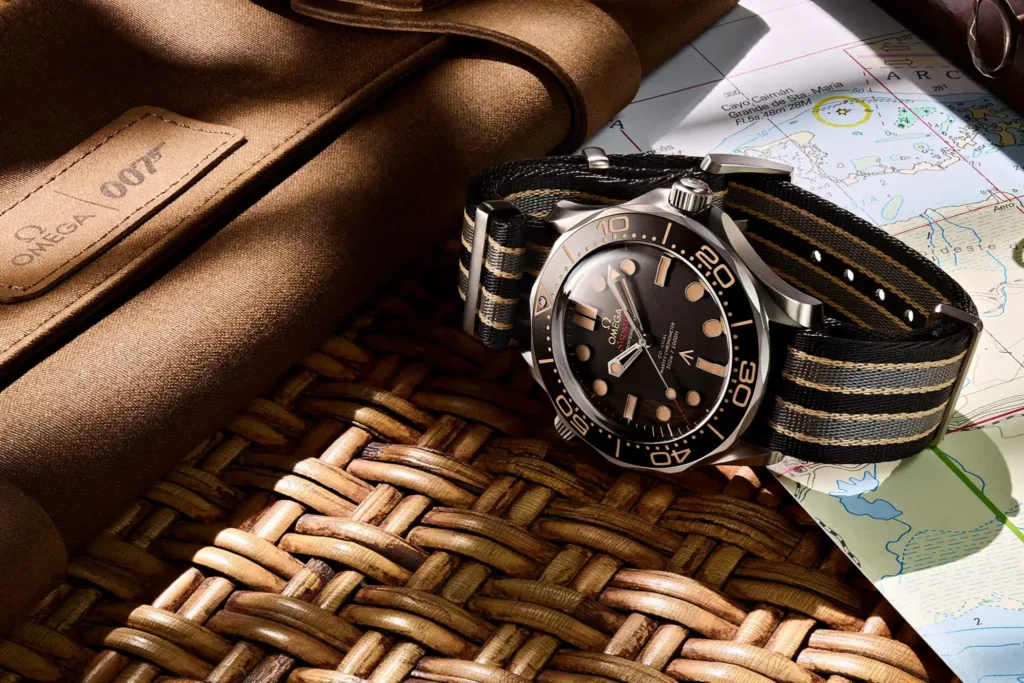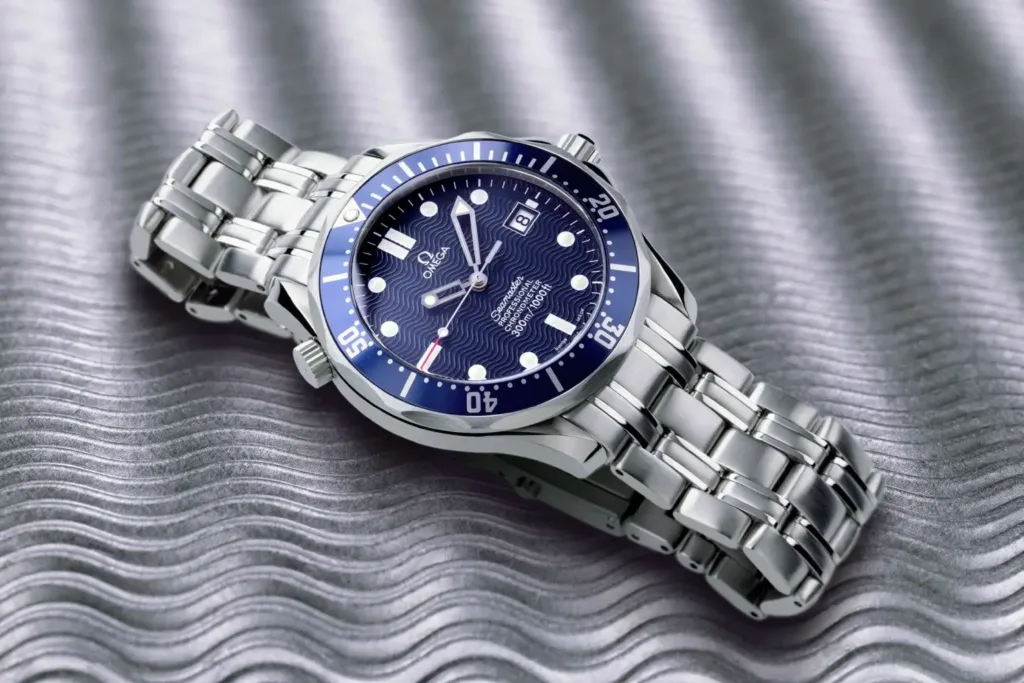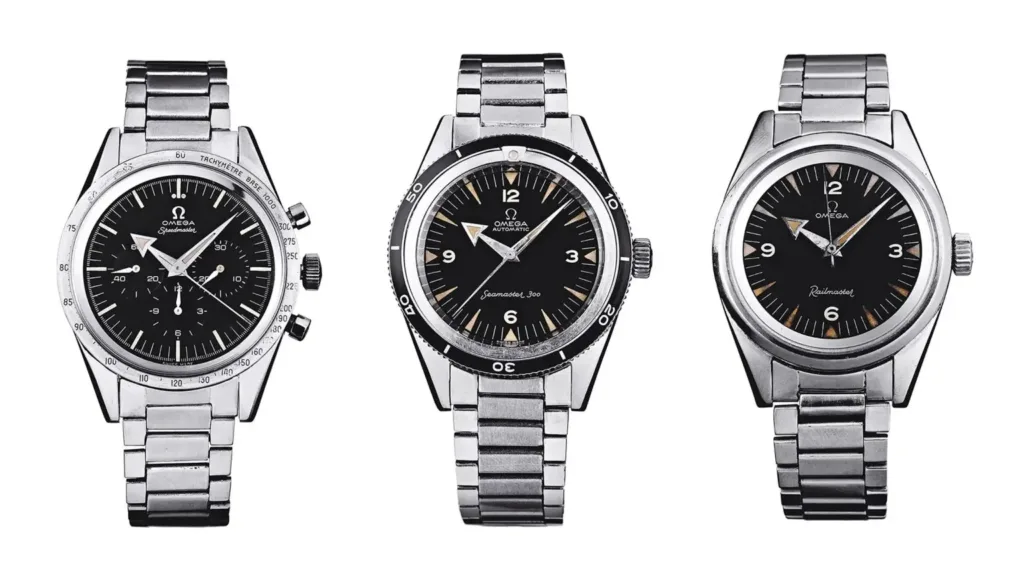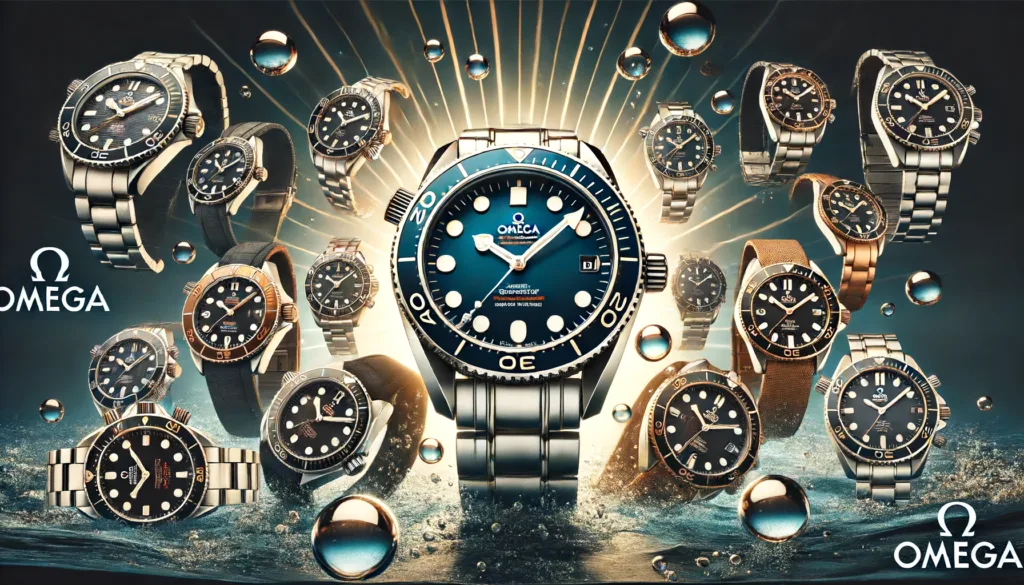The Omega Seamaster is a top pick among dive watches and stands as a key line in the Omega brand. Today’s fans have a lot to choose from: tough, sporty designs (like the Seamaster Diver 300M), sleek looks inspired by the sea (the Aqua Terra), and classic styles (like the Seamaster 1948), along with different colors and materials from steel to titanium to advanced ceramics and special gold mixes. It’s hard to believe this wide range started with just two key designs: a fancy watch from 1948 and its follow-up made for diving fans in 1957.
For a broader overview of diving watches, check out our Comprehensive Guide about Diving Replica Watches
Military Roots of the Omega Seamaster
Launched in 1948 to mark Omega’s 100th year, the Seamaster was set to be a highlight. Yet the original looked nothing like today’s model, famous for being James Bond’s choice on screen. Back then, the idea of a “dive watch” as we know it didn’t really exist. The first Seamaster was more of a fancy wristwatch for everyday wear, made special by its new, wartime-tested waterproof system. This system used a rubber O-ring, like those in submarines, making it more trustworthy against leaks than previous methods. It showed its strength in 1955 when diver Gordan McLean wore it for a deep dive off Australia and in 1956 on a tough journey across the North Atlantic.
The Class of ’57
1957 was a big year with the release of three “Master” watches, each paying a bit of a nod to the original Seamaster. There was the Railmaster for those working around high magnetic fields, the Speedmaster for racing timekeepers, which later became famous as the first moon watch, and the Seamaster 300. This model was a true dive watch, ready for the growing number of diving hobbyists, and could handle depths that its name suggests, though only tested to 200 meters then. It even got worn by diving legend Jacques Cousteau, who joined him on groundbreaking dives.
Going Deeper into Omega Seamaster
The quest for better water resistance didn’t stop, and in the 1960s and 1970s, Omega pushed further. In 1970, working with diving company COMEX, Omega brought out the PloProf (short for “professional divers” in French), hitting new depths of 600 meters. Later, a model that reached 1,000 meters came out. Though it was more of an oddity loved by serious diving buffs than a mainstream hit, it was a record-setter in itself and was worn by Cousteau. Omega brought the PloProf back in 2009, beefed up to withstand 1,200 meters, and it stays in the lineup.
Omega Seamaster and James Bond
The Omega Seamaster Diver 300M, evolving from the original 300, gained big fame in the 1990s as James Bond’s watch. Bond movies, starting in 1963, had various actors and watches, but starting in 1995 with Goldeneye, which brought in Pierce Brosnan, Bond consistently wore an Omega. Just before this, in 1993, the Seamaster got a fresh look with a blue bezel, special hands, a five-link strap, and a wave-pattern dial. Initially, Brosnan’s Bond wore a quartz version, though other options had automatic movements. By 2006, when Daniel Craig stepped into Bond’s shoes in Casino Royale, the Seamaster 300 got an upgrade with Omega’s co-axial movement. The latest update in 2018, for its 25th anniversary, brought back the wave dial and added new features.

Growing the Omega Seamaster family
After 2000, as fancy watch gears came back in style, Omega grew its Seamaster line, first adding the Aqua Terra in 2002, then the Planet Ocean in 2005. The Aqua Terra, compared to the zippy Diver models—and nodding to the first 1948 Seamaster—drops the spinny Diver’s bezel and other heavy-duty bits for a sleek look. Its face shows clean, sharp hour marks like a sailboat shape, a three-pointed hour hand with an arrow minute hand, and—since its 2017 update—a dial with lines that mimic a boat’s wooden deck. Aqua Terra is linked with Omega’s backing of golf events and top pro golfers.
On the flip side, the Planet Ocean was made as a posh yet handy dive watch from the start. Taking cues from a 1960s Seamaster, it’s different from the Diver models in a few ways: the edged, one-way bezel with an aluminum (and later ceramic) top, the dim dial with numbers at 12, 6, and 9, plus arrow-shaped hands, the bubble for releasing helium at 10 o’clock, and, key for diving, a 600-meter water-proof knack, twice as much as the Seamaster Diver.
The first versions had Omega’s twisty Caliber 2500 under a solid back carved with a seahorse, a mark of Omega’s water-ready watches. Like the Aqua Terra, the Planet Ocean line grew to include time-stop and GMT roles, and some appeared in Bond movies, like 2006’s Casino Royale and 2008’s Quantum of Solace.
Old is New Again
With a keen eye on old styles today, anything old can become fresh again. In 2017, Omega marked 50 years since its big year in 1957 with new versions of the Railmaster, Seamaster 300, and the “pre-Moonwatch” Speedmaster—three timeless watches from that year.
The new Seamaster 300 took after the sought-after Ref. CK2913, sporting a bold black dial, “Broad Arrow” hand, deep-set triangle hour marks, and a two-way (rather than updated one-way) spinny bezel, now in aluminum. Packed with an Omega Master Chronometer engine, Caliber 8806, it also showed the old Naiad mark on the crown—a hint at great water resistance in ’57—and a true-to-form Seahorse sketch on the back.
The “non-Diver” Seamaster 300 with a hint of the past won over fans, leading Omega to extend the line with more case types, bands, and colors (and one-way bezels). James Bond even wore a Seamaster 300 with a NATO strap in 2015’s Spectre. The Railmaster, more under the radar, stayed within the Seamaster family, with Omega launching more models in the following years.
Soon, the very first Seamaster from 1948 got its modern turn, timed with its 70th anniversary in 2018. Available as either a three-hand or a small-seconds style, the up-to-date Seamaster 1948 pieces came in gentle, era-like 38-mm cases with creamy domed dials, using 18k white gold for hands, stick-on numbers and marks, and the retro Omega symbol below 12 o’clock.
Both styles came fitted with up-to-date Master Chronometer gears. Omega then put out even rarer platinum-cased versions, making only 70 items later that year. This “dress watch” Seamaster stays in the lineup, shaping many of Omega’s city-themed special shops.
A New Record for the Omega Seamaster
Omega broke records (and one-upped Rolex in their dive-watch clash) in 2019 when a test watch named the Seamaster Planet Ocean Ultra Deep went over 10,928 meters (or 35,853 feet) deep in the Marianas Trench on a dive led by sea explorer Victor Vescovo. This beat the previous record by the Rolex Deepsea during James Cameron’s 2012 dive, making Omega’s the most water-proof watch known. The test piece, made of titanium and huge at 55 mm wide and 28 mm thick, wasn’t really for daily wear.
But in 2022, Omega came out with a daily-wear version named the Planet Ocean Ultra Deep. Made in a strong titanium or a new mix called O-megasteel, the sizes were cut to 45.5 mm wide and 18.2 mm thick—still big but easier on the wrist—and kept a strong water-proof level of 6,000 meters.
Each watch was tested to 7,500 meters—not as extreme as the prototype but still top-tier for underwater strength; the Rolex Deepsea goes up to 3,900 meters. The debut of the Ultra Deep, following the refresh of the Seamaster 1948, shows Omega’s drive to keep renewing its historic dive watch in both look and function. Below, I spotlight the different Seamaster groups, focusing on some standout market picks. (Prices vary a lot because of different materials, extras, and, in some picks, fancy stones and metals in the dials.)

The Best Omega Seamaster Diving Watches
Seamaster Diver 300
In 2018, the Seamaster Diver 300M got back some features from its 1993 update, like the wave pattern on the dial and special hands, but also got some new upgrades. This includes a ceramic unidirectional bezel for diving, a bigger case size of 42mm (some models are even bigger at 43.5mm), and an important change to an Omega in-house automatic movement, the Master Chronometer-certified, co-axial Caliber 8800. Both the dial and the bezel’s dive scale are made of ceramic now, and they use lasers to etch the wave design on the dial. The back of the case of most new models has a clear window to see the movement, which was not common in earlier versions of the Seamaster Diver. The latest model, unveiled at Omega Days 2022 in March, shows off a deep green wave-pattern dial and a matching green ceramic bezel with a white dive scale.
Seamaster Diver 300M Chronograph
The Seamaster Diver 300M has two main types of chronograph watches: one with a two-register dial powered by the automatic Caliber 9900 and another with a three-register dial that uses the automatic co-axial Caliber 3330. Both have a date display at 6 o’clock, a helium release valve at 10 o’clock, and buttons for the chronograph that are screwed down, sitting next to the crown that’s also screwed down.
Seamaster Aqua Terra 150M
The Seamaster Aqua Terra offers a wide range of choices in sizes, materials, and colors and even includes some watches with extra features, from a small seconds hand to a GMT and chronograph to Omega’s first, and as of now only, world-time watch (highlighted below). In 2022, the line added five new Aqua Terra models in 38-mm cases and five in 34-mm cases, all in shiny stainless steel on bracelets. These new models have dials with a sunburst finish in various bright colors, moving away from the usual teakwood pattern.
Seamaster Aqua Terra Worldtimer
The most complex watch under the Aqua Terra line has a dial with multiple levels, showing a globe with an outer ring of sand-blasted platinum-gold alloy, yellow-gold markers, and a ring with the names of world cities in three different colors: red for London (GMT 0), black for places with daylight saving time, and blue for those without. Omega’s home city of Bienne, Switzerland, is listed instead of Paris for GMT +1. The center has a sapphire disk with a hand-made enamel map of the world from the North Pole view and a 24-hour ring that shows day and night. The case is also platinum-gold, 43 mm wide, with a wavy-edged back that shows off the movement of Omega’s self-winding Caliber 8939. The first version was limited to 87 pieces, followed by a non-limited steel version.
Seamaster Planet Ocean 600M
The Ultra Deep models have been in the news a lot lately, but they are just the latest in the Planet Ocean line, which has many choices for both serious and casual divers. The Planet Ocean was the first Seamaster to use an Omega co-axial movement and now includes even more advanced Master Chronometer movements, except in the smallest models. Notable are the Planet Ocean “Deep Black” models from 2016, the first ceramic dive watches tested for water resistance to 600 meters. The chronograph version uses the Master Chronometer co-axial Caliber 9900, showing both 60-minute and 12-hour counts on one subdial for easy reading of time passed.
Seamaster Planet Ocean 600M GMT Big Blue
Omega has a few GMT options in the Planet Ocean collection, with the standout being the Big Blue edition. Following the Deep Black, it’s Omega’s first watch made entirely of blue ceramic. The series’ key colors, orange and blue, are used throughout, including in the 24-hour GMT ring and the first 15 minutes of the diving scale on the bezel, mixing orange rubber and ceramic. The large 45.5mm case holds the Master Chronometer Caliber 8906, which has a 60-hour power reserve and a built-in GMT function.
Seamaster 300
The most substantive differences between the modern Seamaster 300 and its 1957 ancestor are technical rather than aesthetic: the former’s water resistance is rated to the 300 meters alluded to in its name; the bezel (with the exception of the Trilogy limited edition) turns in one direction rather than two, a safety measure to prevent accidental resetting of the time underwater that is now common in dive watches; and the movement is both COSC- and Master Chronometer-certified. The dial design, with the Broad Arrow hands and wedge-shaped markers, is very faithful to the original’s. Today, the once-humble tool watch offers options in bronze, titanium, and Omega’s proprietary Sedna gold, as well as numerous models in steel.

Seamaster 1948
The dressiest and most retro in style of the Seamaster family, the Seamaster 1948 is a range of limited editions, all in modest 38mm cases made of steel or platinum, often with gold details on the dials, and equipped with Master Chronometer movements. Distinguishing these exclusive models from the rest of the collection, as well as from their historical predecessors, are the flat sapphire casebacks that have been laser-engraved and lacquered by hand with a 70th Anniversary logo and two images paying tribute to Omega’s history as a watch provider to the military: a Chris-Craft boat and a Gloster Meteor aircraft.
Seamaster Railmaster
Only recently resurrected for its 60th anniversary year, the Railmaster sub-family has thus far only a small footprint within the modern Seamaster collection, but its vintage design has been winning over a new generation of enthusiasts. Since the release of the Trilogy limited edition, the most interesting version of the Railmaster came in 2018, with a vertically brushed “blue jean” dial (with a beige printed minute track for the “stitching”) meant to evoke the classical Americana of 20th century railroad workers. Behind the dial, with its retro crosshair motif, beats the Master Chronometer Caliber 8806, whose magnetic resistance of 15,000 gauss is even more robust than that of the 1957 original.




